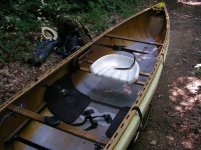I took delivery of a Hemlock SRT about a month and a half ago with idea if using it for tripping on some class II rivers. I tipped it and swam with the fishes within 20 seconds of putting it on water, and I tipped again this afternoon (wearing a dry suit here in Maine). I feel like I'm missing something, like I just don't understand the boat.
Let me add that my point of reference is the Northstar Magic, which I trip in, paddle almost daily for exercise and fish from throwing 10" swimbaits with a 8 1/2 foot rod. I feel super stable in the Magic.
Can anyone offer some insight?
Thanks.
Let me add that my point of reference is the Northstar Magic, which I trip in, paddle almost daily for exercise and fish from throwing 10" swimbaits with a 8 1/2 foot rod. I feel super stable in the Magic.
Can anyone offer some insight?
Thanks.

